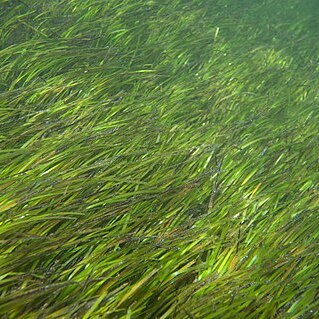Rhizome creeping, with 1-6 roots and a short erect stem at each node; internodes 0.5-4 cm long; scales ovate or elliptic, up to 6-7 mm long. Leaf sheath 1-3.5 cm long. Leaf blade 6-15 cm long and 0.25-3.5 mm wide, narrowed at the base, sometimes falcate; midrib conspicuous, widening and sometimes furcate near the apex; tip with 2 linear lateral teeth and an obtuse (but in very narrow specimens often acute) median tooth in which the midrib ends; median tooth as long as or shorter than the lateral teeth, rarely slightly longer, or not developed at all. Male ‘flower’ on a 6-20 mm long stalk; anthers 2-3 mm long, coloured red by numerous tannin cells; the upper anther attached 0.25-0.5 mm above the lower one. Female ‘flower’: ovary ovoid, 1 mm long; style 28-42 mm long, terminal. Fruit subglobose-ovoid or globose, slightly appressed, 2-2.5 by 1.75-2 mm, with a 0.25-1 mm long apical beak.
Gregarious marine herb; rhizome 1.5– 2.5 mm in diam.; each node with 1– 6 roots and erect stem to 5 cm long; internodes 0.5– 5 cm long; scales ovate or elliptic, 4– 9 mm long.. Leaf with sheath 1– 4 cm long; blade sometimes falcate, 5– 18 cm long, 0.25– 3.5 mm wide, base narrowed, apex with 2 linear lateral teeth and an obtuse (rarely acute) median tooth, midrib conspicuous, widening near the apex and sometimes furcate or bicuspidate.. Staminate flower with pedicel 6– 20 mm long; anthers 2– 5 mm long, red, the upper anther attached 0.2– 0.5 mm above the lower.. Pistillate flower with globose to ovoid ovary 1– 2 mm long, style 10– 42 mm long, terminal or lateral.. Fruit ovoid to globose, slightly compressed, 1.5– 2.5 mm long and 1.7– 2 mm in diam., with a 0.2– 1 mm long apical or lateral beak.. Fig. 3.
Rhizome 1–2 mm diam.; internode 5–40 mm long; scales ovate or elliptic, to 7 mm long. Roots 2–5 per node. Stem with 2–4 leaves. Leaf sheath 15–35 mm long. Leaf blade linear, 5–15 cm long, 0.5–4 mm wide, narrowed at base; apex tridentate with 2 lateral teeth and 1 obtuse median tooth. Male flower: stalk 15–20 mm long; anthers 2–3.5 mm long; upper anther attached 0.25–0.5 mm above lower anther. Female flower: ovary ovoid, 1 mm long; style 20–35 mm long. Fruit usually 2, subglobose to ovoid, 2–2.5 mm diam.; apical beak 0.25–1 mm long.
Internodes of rhizome 2.5-3(-5) cm. Scales elliptic, membranous. Leaves narrowly linear, 4-11(-15) cm × 0.8-1.4 mm, veins 3, midvein conspicuous, basally gradually narrowed, lateral teeth conspicuous, apex trifid; sheaths 2-3 cm. Flowers small. Peduncle of male flowers 1-2 cm; anthers ca. 0.5 mm. Style of female flowers 3-4 mm, apical. Fruitlet ovoid, ca. 2.5 × 2 mm; beak apical, ca. 1 mm.


